NAT 24.3%
Incumbent MP
Thomas George, since 1999.
Geography
Northern NSW. The seat of Lismore covers the entirety of Lismore, Kyogle and Tenterfield council areas, and western parts of the Tweed council area. The seat covers the towns of Lismore, Murwillumbah and Kyogle, and stretches as far west as Mingoola.
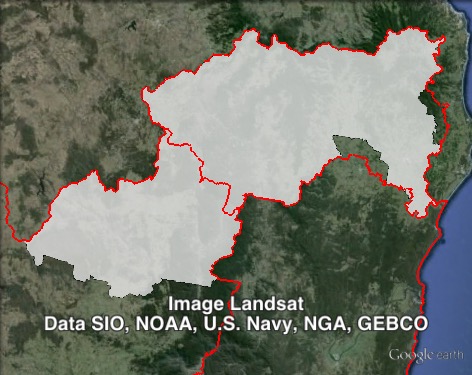
Redistribution
Lismore underwent a number of changes. The electorate previously covered the western fringe of Byron shire, which was transferred to the seat of Ballina. The seat also covered parts of the Richmond Valley council area north of Casino, and these areas were transferred to Clarence, in exchange for a small part of Lismore council area contained in Clarence, effectively aligning the Lismore-Clarence boundary with the council boundary. Further west, Lismore gained the remainder of Tenterfield council area from Northern Tablelands. These changes had no impact on the electorate’s margin.
History
The seat of Lismore was first created in 1894, and has existed for most of that period, and continuously since 1927. It has been dominated by the Country/National Party since 1927.
The seat first existed from 1894 to 1904, when it was abolished. It was restored in 1913, but in 1920 it was merged with the neighbouring seat of Byron. Byron became a three-member district covering the former districts of Byron, Clarence and Lismore.
In 1927, Lismore was restored, and was won by Country Party candidate William Missingham, who had held one of the seats in Byron since 1922. Missingham held the seat until his death in 1933.
At the 1933 Lismore by-election, the seat was won by William Frith, one of three Country Party candidates standing. Firth held the seat until the 1953 election. As he had turned 70 prior to that election, Country Party rules allowed multiple candidates to stand, and Frith was defeated by fellow Country Party candidate Jack Easter.
Easter retained his seat with ease in 1956. At the 1959 election, he was challenged by independent candidate Clyde Campbell, and held onto the seat by only two votes. A court decision saw a Lismore by-election called for later in 1959.
At the by-election, Campbell and Easter were both endorsed by the Country Party. The ALP ran Keith Compton, who won 47% of the primary vote. Despite the two Country Party candidates polling a majority of the vote, enough of Campbell’s preferences leaked to Compton to give him the seat.
Compton retained the seat in 1962, and lost in 1965 to Country Party candidate Bruce Duncan.
Duncan held the seat throughout the 1970s as the party became the National Country Party. In 1982, the party changed its name to the National Party. Duncan objected to the name change, and resigned from the party. While he sat as an independent, he was not opposed by the National Party in 1984, when he was re-elected as an independent. He retired at the 1988 election.
Bill Rixon won Lismore for the National Party in 1988. He held it comfortably over the next decade, and retired in 1999. He was succeeded in Lismore by fellow National Thomas George. George was re-elected in Lismore at the 2003, 2007 and 2011 elections.
Candidates
- Adam Guise (Greens)
- Alan Jones (No Land Tax)
- Thomas George (Nationals)
- Isaac Smith (Labor)
- Gianpiero Battista (Christian Democratic Party)
- Cherie Imlah (Animal Justice Party)
Assessment
Despite a sizeable margin and a long history of Lismore being won by the Nationals, both Labor and the Greens believe they have a chance of making significant inroads into the Nationals vote. Regardless of this optimism, the most likely outcome is still a Nationals win.
2011 election result
| Candidate | Party | Votes | % | Swing | Redist |
| Thomas George | Nationals | 27,371 | 61.2 | +7.0 | 59.1 |
| Susan Stock | Greens | 9,157 | 20.5 | +2.7 | 18.9 |
| Andrew Moy | Labor | 5,902 | 13.2 | -12.4 | 12.9 |
| Russell Kilarney | Independent | 1,514 | 3.4 | +3.4 | 3.1 |
| Margaret Kay | Christian Democrats | 801 | 1.8 | +1.8 | 1.7 |
| Others | 4.2 |
2011 two-candidate-preferred result
| Candidate | Party | Votes | % |
| Thomas George | Nationals | 28,993 | 70.2 |
| Susan Stock | Greens | 12,307 | 29.8 |
2011 two-party-preferred result
| Candidate | Party | Votes | % | Swing | Redist |
| Thomas George | Nationals | 29,046 | 74.3 | +14.3 | 74.3 |
| Andrew Moy | Labor | 10,041 | 25.7 | -14.3 | 25.7 |
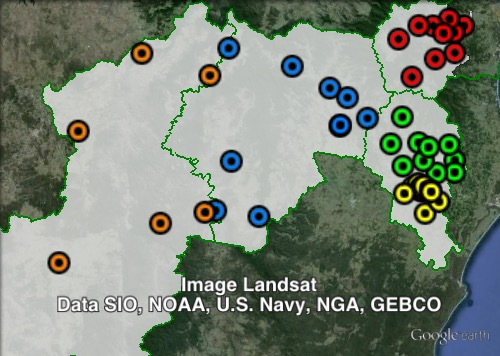
Booth breakdown
Booths in Lismore have been split into five areas. Polling places in the Kyogle, Tenterfield and Tweed council areas have been grouped together. Polling places in the Lismore council area have been split in two parts: Lismore North and Lismore South. Lismore South covers the town of Lismore itself.
The Nationals primary vote ranged from 42.5% in Tenterfield to 66% in Lismore South. The low Nationals vote in Tenterfield is not due to a high Labor or Greens vote – the area is lowest for all three parties. It reflects the very high vote for independent MP Richard Torbay in Northern Tablelands in 2011, and the fact that a majority of this area has been redistributed into the electorate since 2011.
Excluding Tenterfield, the Greens vote ranged from 15.7% in Lismore South to 36% in Lismore North. The Labor vote ranged from 11.7% in Lismore North to 16% in Tweed.
| Voter group | NAT % | GRN % | ALP % | Total votes | % of votes |
| Lismore South | 66.0 | 15.7 | 13.4 | 15,790 | 35.4 |
| Tweed | 53.1 | 24.2 | 16.0 | 6,489 | 14.5 |
| Lismore North | 48.1 | 35.9 | 11.7 | 4,790 | 10.7 |
| Kyogle | 64.2 | 17.9 | 13.1 | 4,021 | 9.0 |
| Tenterfield | 42.5 | 4.8 | 7.0 | 2,313 | 5.2 |
| Other votes | 59.2 | 16.5 | 11.9 | 11,255 | 25.2 |
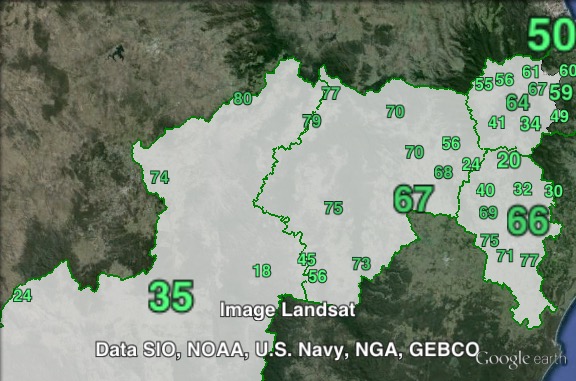
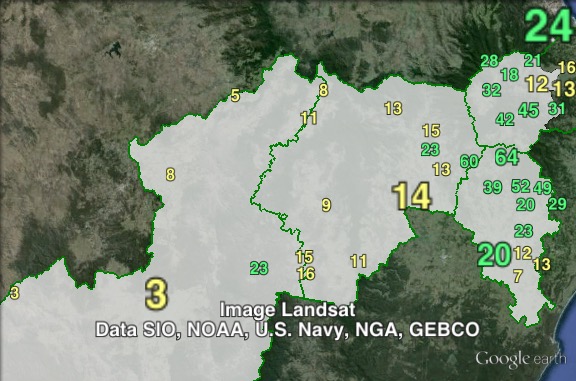
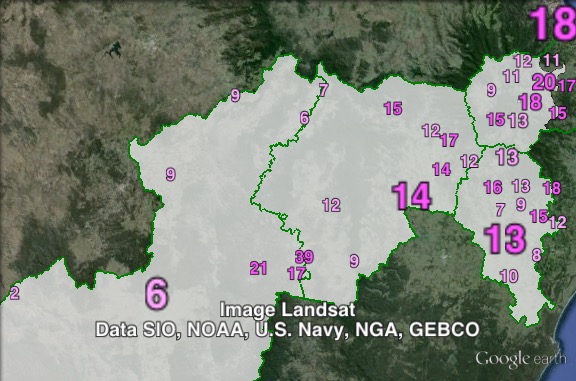
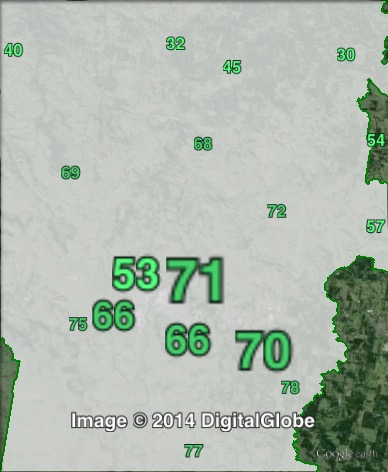
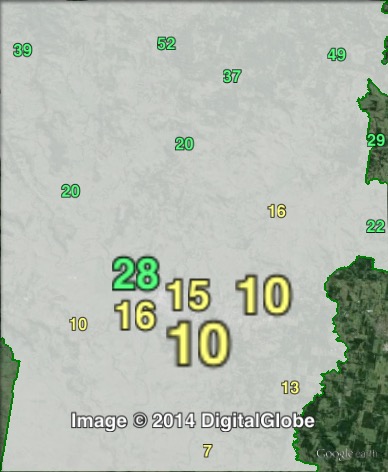
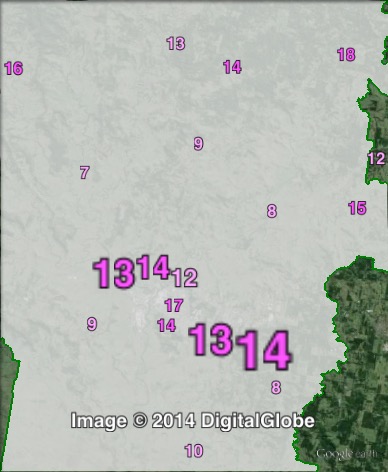
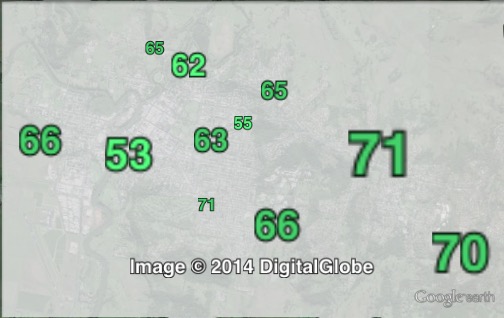
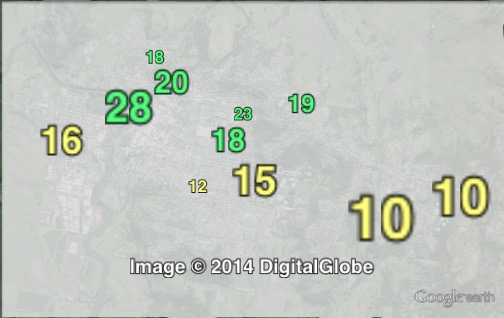
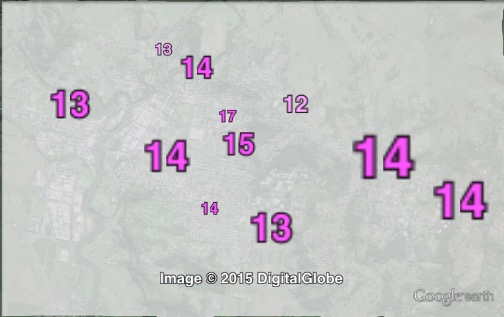


This is a seat is one being talked up by the Greens as a possibility. There are some very strong Greens booths in this electorate – a few booths in the 40’s, a couple in the 50’s and a couple in the 60’s – the problem is that they are all concentrated in the eastern end of the electorate, and pretty much dies out from the Kyogle and west of that.
It will be interesting to see how well the Greens do here on election day. One would have to think that the margin is just too much to unseat the sitting member.
My prediction: National hold, unless Labor do REALLY well.
I live in this seat and get called by a pollster at least once a fortnight for the last six months, so something is going on here.
There is a precedent for the Greens doing potentially quite well here. Think Kimberley WA 2013. The CSG factor hasn’t appeared to have much of an impact in elections to date, but in an election where there aren’t other huge influences on voting, this is where it should have the biggest impact it ever has, and maybe ever will.
Thomas George, who had previously been a reasonably active local MP, seemed to have gone into hiding for most of this term. Many people are surprised that he’s running again.
It’s been said that Labor polling has the Nats on only 34%, worse than they are polling in Ballina. That doesn’t surprise me, this is the seat where CSG really is an issue that has permeated across the community, and into towns where the votes are, not just rural areas. I tipped this last year as a better prospect for the Greens than Ballina, but unfortunately the complication of the independent running in Ballina now means we’ll never know if I was right or not on its own.
The fact we haven’t had a prominent anti-CSG campaigner nominate as an independent is partly a sign of how much support Adam Guise has. The difficulty for the Greens in actually winning though is whether or not they have the organising capacity and the experience of running a campaign of the scale and intensity needed to win a hotly-contested seat in this region.
The geographic diversity of the seat is also a challenge for either the Greens or Labor in defeating the Nats. I won’t be surprised if there are huge variations in swings across the seat.
Isaac Smith is the strongest candidate Labor have nominated here for a while. Last election there was practically no campaigning from any party – this time plenty.
I’d definitely recommend watching this as a potentially intriguing 3-way contest on election night.
Some sense of humour no doubt in the No Land Tax party’s choice of a Mr Alan Jones (from Campsie) as their candidate here.
People often comment how poorly Labor do in the Far North Coast at a state level, when compared to their federal results, but the opposite could be said for the Greens. I think they only got 7 or 8 % in Page at the last federal election, but have got 15-20% here at a state level for a few elections.
Yes but Page includes Casino and Grafton, which are not favourable areas for the Greens, and since 2007 it has not included the northern half of the Lismore LGA which is their best area. Add to that Janelle Saffin being one of Labor’s most progressive MPs which accounts for another percent or so.
Good article by The Guardian:
http://www.theguardian.com/australia-news/2015/mar/26/in-vast-swaths-of-rural-new-south-wales-theres-only-one-election-issue-coal-seam-gas
Labor now slight favourites with the bookies in Ballina, but slipped to third in Lismore.
George – $1.40, Guise – $4, Smith – $6.
Smith at 6/1 looks like decent odds to me. I don’t think George should be quite that safe and I’m not sold that the Green candidate will poll more than the Labor one. Might be a bit of a Prahran situation here.
The Greens were dealt a winning hand here, but they haven’t been able to play it. If your campaign can’t distribute leaflets and can’t have a constant presence at prepoll I don’t see how you can be a serious contender. I shouldn’t be surprised since i knew the Northern Rivers Greens don’t have the organisational capacity to mount a campaign of the scale and professionalism to win. I was under the impression though that the popular candidate and upswell of community interest following the Bentley blockade may have been able to change this, but the ‘lifestyle Greens’ (as someone I know once described them) who make up the party’s membership and activist base in this seat just don’t have the political nouse or awareness to understand what needs to be done.
Nick seems to be correct – the Greens did well in the booth vote but the Nats are clawing it back with the prepoll. It now looks like the Nats will hang on to this one.
I haven’t noticed if this has been a pattern elsewhere, but as the amount of people voting prepoll has increased in recent years it seems to have become much worse for the Greens in this area. Prepolls in the 2013 federal election were shockingly bad for the Greens.
It’s very hard to get hippies to spend a whole day at a prepoll booth. Labor’s troops tend to be more disciplined.
Well tbh yes I do remember we had a few instances in the 2011 Lismore campaign of folks wandering off part-way through their shift at prepoll, so they may well have had the same issue there, but all parties can run into those problems and just have to roster people who are more reliable. I was the overall volunteer co-ordinator for Richmond in 2013, and my understanding was the prepoll booths were attended continuously, including by the candidate herself at Tweed Heads basically whenever she had any spare time in her schedule, and it didn’t seem to help much at all. The cohort of people who are increasingly voting prepoll seem to be predominantly conservative.